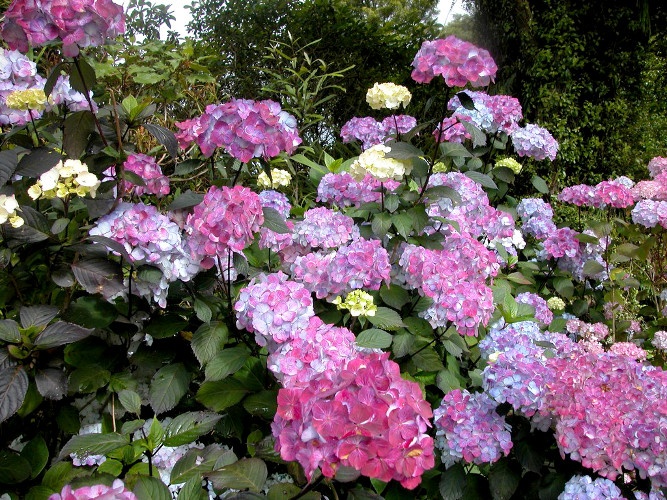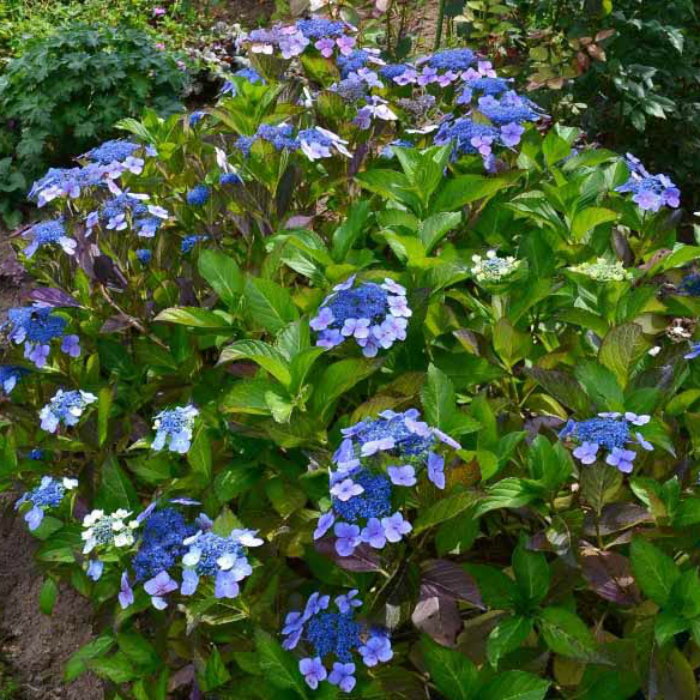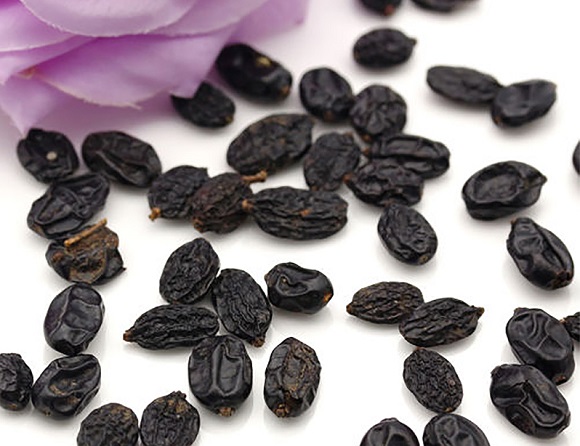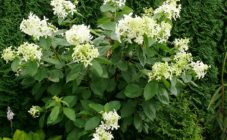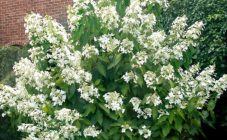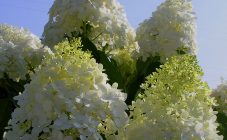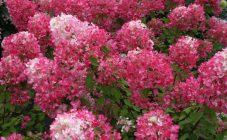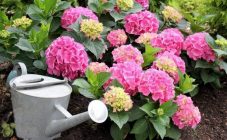Content:
Serrated hydrangea is grown in Russia. It blooms with beautiful flowers of delicate shades. With proper agricultural technology, the bushes grow, annually pleasing with their lush flowers.
Description of the plant
Hydrangea serrata is a type of large-leaved hydrangea. The homeland of the ornamental plant is East and South Asia. Blooming flowers will be a wonderful decoration for a garden plot, they can be included in the composition of bouquets, dried and made ikebana.
There are several varieties of this species:
- Hydrangea serrated Bluebird;
- Hydrangea Preciosa.
Description of the plant:
- Shoots are erect, grow up to 150 cm in height, up to 60 cm in width;
- The leaves are rich green, oval in shape, the end of the leaf is pointed;
- The inflorescences are lush in the form of a cap, lacy, the petals are concave and convex;
- Barren flowers are blue or pink, fertile flowers are blue or white;
- The color of hydrangea finely sawed is influenced by the composition and acidity of the soil;
- The flowering period begins in June. Depending on the variety, the flower can decorate the garden until September;
- The plant is perennial, it is necessary to make a shelter for the winter.
Agrotechnics
Conditions for active growth of hydrangea:
- The flower will grow and bloom well in fertile, moist soils;
- The acidity level of the soil should be 5.5 pH;
- If the acidity level is neutral or alkaline, then the soil is acidified by adding aluminum sulfate or peat to it;
- The plant can be planted in partial shade;
- The flower does not tolerate drafts, it cannot be planted on the eastern side of the site;
- The bushes are considered winter-hardy, but when the temperature drops below -28 degrees, a shelter must be made for the hydrangea.
Advantages of serrata hydrangea:
- It does not require special care;
- Rarely exposed to diseases and pests;
- Winter hardiness;
- Long flowering period.
Landing
Hydrangea Bluebird is planted in open ground in the second decade of April. By this time, the earth warms up enough, thaws completely.
A favorable place for planting a flower is partial shade without drafts. Under such conditions, the hydrangea will bloom with voluminous flowers.
Bluebird hydrangea planting and care scheme:
- Prepare a nutritious soil mixture consisting of peat, sand, rotted foliage and fertile humus in a ratio of 1: 1: 2: 2;
- Dig a hole, 30-35 cm deep;
- Put the prepared soil mixture on the bottom of the hole;
- Place seedlings in the center of the hole, the root collar should be flush with the ground;
- Sprinkle the empty space with earth;
- Plants when planting are placed at a distance of 1 m from each other;
- Pour water over the well, add mulch (sawdust, needles), layer thickness - up to 10 cm.
Care
Flower care recommendations:
- At temperatures up to 25 degrees, it is necessary to water the bushes in the morning and evening hours. If the days are hot (+30 degrees and above), then the number of waterings is increased. But you can not get on the leaves of the flower, especially in the bright sun;
- Hydrangeas will grow well in partial shade conditions;
- You can get rid of weeds and loosen as needed. Loosening promotes better oxygen penetration into the soil and is a good prophylaxis against parasites and diseases;
- Adult bushes need to be fed during the flowering period. For fertilization, it is recommended to use special balanced mineral preparations intended for hydrangea. Observe the dosage and feeding time, according to the recommendations on the package;
- Bushes need pruning as they grow. The procedure is carried out in the autumn, removing dry and damaged stems. Every 2 years, for preventive purposes, remove all excess shoots. The procedure improves the condition of the bush, strengthens it.
Hydrangea blooms in July-September with normal development. The flowering period depends on weather conditions, sometimes flowering can end in August.
There are several reasons why hydrangea Bluebird does not bloom:
- Lack of moisture;
- The peculiarity of climatic conditions, soil composition;
- The root system is poorly developed;
- Insufficient illumination of the site;
- Incorrect pruning of bushes in the spring;
- The bushes were frozen in winter.
You can restore flowering on your own if you take into account the rules for care, recommendations for choosing a site and soil composition.
Preparing for winter
In the autumn, prophylactic pruning of hydrangeas is carried out. It is recommended to treat bushes with drugs against pests and diseases. After the foliage has completely fallen off, the bushes are sprayed with 3% Bordeaux liquid.
In September, you can transplant a plant to a new location.
The hydrangea has good frost resistance, but the garden flower needs shelter for the winter. From September, you can begin to cover the bushes. It is necessary to cut off all the lower leaves to the middle of the bush. After that, mineral fertilizers (superphosphate and potassium salt) are added to the hole.
The branches are carefully tied, forming a bundle, you can slightly bend them to the ground. Then they are covered with two layers of special material (spunbond, density g / sq. M). It is better to cover it without waiting for severe frosts.
Reproduction of culture
There are several breeding options for hydrangea. The most common is grafting. Cuttings are cut in summer from healthy and strong bushes.
Tips for germinating cuttings:
- For root growth, cuttings are placed in water with the addition of special preparations (Etamon, Kornevin, Heteroauxin, Zircon);
- For sprouting roots, you can use the folk method: 1 teaspoon of honey in a glass of water;
- After good roots are formed, the cuttings can be planted in open ground. After 4 weeks, they should take root in a new location. A prerequisite is the presence of a shelter;
- In late spring, young bushes can be transplanted to a permanent place.
Another uncomplicated way to reproduce hydrangeas is by layering. It is necessary to choose a strong adult bush, in the spring, dig in the lower branches along the entire length. In the fall, shoots are formed on the dug-in layers, next spring they can be planted in a permanent place.
Tips for rooting hydrangea seedlings in the fall:
- Clean the seedling from leaves and shoots;
- Arrange the branch so that it is at the top, the roots at the bottom;
- Sprinkle the roots with earth;
- Make shelter.
The easiest way is to divide an adult bush. This is the most optimal way to transplant a plant.
Propagation of hydrangea serrata by seeds
Seed propagation is used if you need to get a lot of seedlings. The seeds can be purchased at the store.
For planting seeds, you need to prepare containers, pots, a nutrient substrate.The soil mixture is prepared from peat, river sand and leaf mixture in a ratio of 2: 1: 4, respectively.
Seed planting scheme:
- Place a nutrient substrate in a container, lay out the seeds, deepening them by 0.5 cm;
- Sprinkle the seeds on top with a layer of soil;
- Moisten with a spray bottle;
- Cover containers with glass and place in a bright place;
- Moisten the soil constantly, do not dry out;
- Remove the glass periodically, ventilate the seed;
- After emergence, the glass is removed;
- When 2 true leaves are formed, the seedlings are ready for picking;
- The soil for diving into separate pots is used the same as when planting seeds;
- Seedlings are watered as the soil dries up;
- When warm spring days come, mature seedlings can be planted in open ground under a shelter.
Serrated hydrangea is an openwork flower that will be an unusual decorative element in the garden. Even novice gardeners can grow it. If you follow the care recommendations, then the bushes will be lush and healthy for many years.
